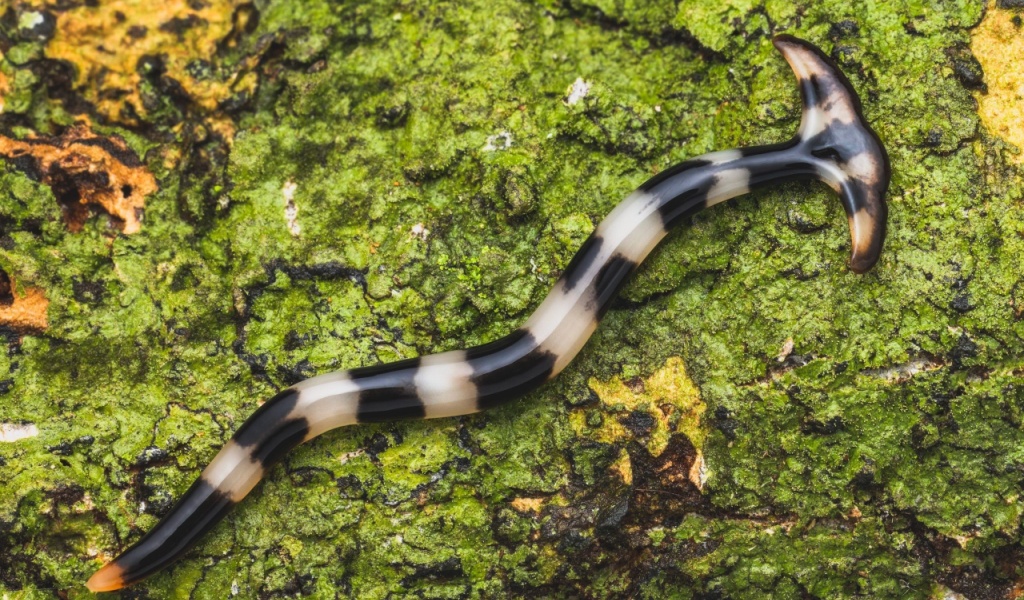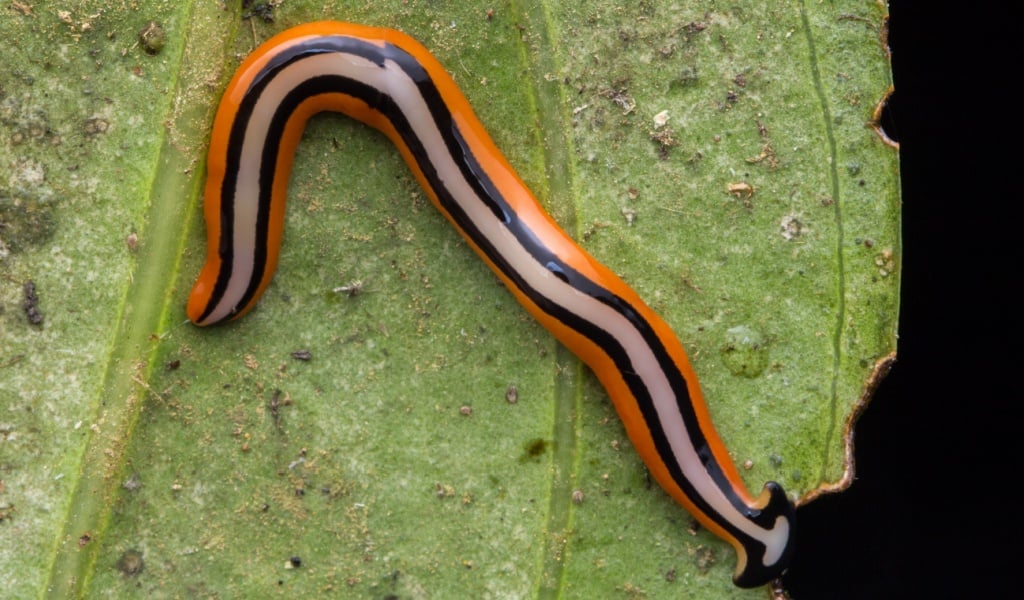Americans are prone to hearing about a new killer invertebrate invading the country. From fire ants and killer bees to murder hornets and much more, the newest invasive creature to appear in backyards across the United States is a strange worm. Not only is this worm unusual to look at, but it has some unique characteristics, too. For example, it can reproduce by splitting itself into two. Plus, it secretes the same toxins found in pufferfish.

So, what are these creatures?
Hammerhead worms are an invasive species of toxic terrestrial flatworms. They live on land and are predators and cannibals. Hammerhead flatworms don’t pose a direct threat to people, but they are predators of earthworms. The eradication of earthworms can significantly impact local ecosystems since they are essential for soil health, which makes the increased prevalence of hammerheads more concerning. Hammerhead flatworms can grow up to 18 inches long and are often mistaken for snakes.
The hammerhead’s most unique feature is its anvil-shaped head, which resembles a hammerhead shark, further adding to its menacing reputation. It has a long, flattened body, and the underside has a creeping sole used for movement. These worms are earth-colored and can be found in shades of brown, green, gray, and gold.
The hammerhead worm is native to tropical countries such as in Southeast Asia. However, it’s not new to the US or other parts of the world and has been a common resident in our gardens since the 1900s. You may typically find them hiding in soil or among objects with moisture.
Hammerhead worms don’t have a respiratory or circulatory system because oxygen and carbon dioxide enter and leave the body by diffusing directly through the body’s surface. They also don’t have a skeletal system, and bizarrely, their mouth is also the anus!
How It Feeds
Since these worms are light-sensitive, you will find them primarily active during nighttime as they feed on small and soft-bodied animals like slugs, snails, earthworms, and other small insects. These slimy invaders prey on smaller creatures, using enzymes to digest their prey externally before consuming them by wrapping them with sticky mucus and ingesting them through the mouth on their belly in the middle of their bodies. After it successfully digests the prey into a puddle, the worm will then use its small hair-like structures called cilia on its underbelly to suck in the prey. These cilia also help them move, acting like microscopic legs to pull the worm along the slimy film it secretes.
How It Reproduces
In general, the life cycle of flatworms is complex and distinct. Hammerhead worms are hermaphroditic, which means they have both female and male reproductive organs. They can reproduce either sexually or asexually, but asexual reproduction is more common. Through sexual reproduction, the hammerhead worm exchanges gametes with another through secretions. The fertilized eggs then develop inside the body and are matured and shed as eggs, which hatch after about three weeks.
Conversely, asexual reproduction occurs via fragmentation. The worm leaves behind a tail tip stuck to a leaf or substrate, which then gradually develops into an adult. Even if the worm is cut into pieces, each piece can regenerate entirely within a few weeks. Like other planaria, hammerhead worms are almost immortal.

Are They Dangerous?
Hammerhead worms are the only known terrestrial invertebrates that produce the same toxin that makes pufferfish so deadly. However, since this toxin is produced in small amounts, it’s not dangerous to humans unless exposed to it in large numbers. So, in most cases, the danger of these worms is exaggerated!
However, these slimy predators are deadly to earthworms. In fact, hammerhead worms, which don’t fertilize or aerate the soil like earthworms do, have been eating not only earthworms but other soil fauna into literal scarcity.
Can They Be Eradicated?
Hammerhead worms are an invasive species that can wreak havoc in your backyard. You can’t kill them by cutting them because they will just regenerate into new worms. Therefore, you should use other methods, like sprinkling salt or citrus oil on the worms directly, which dehydrates and kills them. Otherwise, you can soak them in a container with equal parts water and bleach and throw them out with the trash afterward. Please do not put them in compost because their eggs could live on!
The hammerhead worm’s only goal in life is to survive, and to do that, it must consume earthworms that can damage a fertile ecosystem. Once these cannibalistic worms have devoured all the earthworms in a specific place, they will march to another location to do the same. These creatures can pose a real threat to farmers and gardeners in particular.
If you spot a hammerhead worm, resist the urge to squish it or pick it up with your fingers. These worms carry parasites and toxic secretions that can cause allergic skin irritation. They release tetrodotoxin, which primarily affects the nervous system. So, when you touch one, you could experience mild symptoms such as tingling and numbness. Muscle weakness and difficulty swallowing are other symptoms that can be observed.
Although these worms are not harmful to humans or pets, direct contact should be avoided, and if you have to pick them up, do so while wearing gloves.



